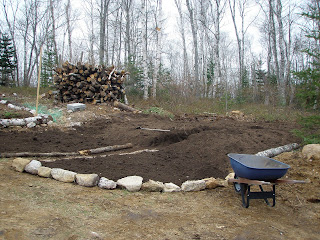


Before you break ground on a new garden, take a little time to think about how you would like to layout the beds. Good planning will enable you to think sensibly about how much space and time you can devote to your garden and what types of vegetables you should grow.
Start by asking a few questions - How many people will be eating from the garden? How much time can we devote to the garden? What do we like to eat? The answers to these questions will give you an idea of how large to make your garden and what to grow.
The most important piece of advice to remember, especially for novice gardeners is to start small. A 4 by 8-foot or 10 by 18-foot garden is large enough for an initial kitchen garden. In a 10 x 18-foot patch, you can divide the space into 4 manageable 4x8-foot beds, with 2-foot pathways. Once you’re spent an entire season planting, growing and harvesting, you’ll know if you want a larger space.
I do recommend sketching out a garden design before you ever put shovel to dirt. It allows you to play with the size and shape of the garden and helps show what you can realistically grow in that sized space. Rectangles and squares are the easiest bed shapes to work with, but I’ve also seen kitchen gardens arranged in spirals, circles and triangular beds. It’s your garden, so have fun with it!
Vegetables are usually grown in rows or beds. I prefer raised beds as it allows me to grow the plants closer together, which offers a larger harvest from a smaller space and helps shade out any weeds. Raised beds also warm up quicker in spring, are better drained and create a very attractive, as well as productive space.
Make your beds no larger than 4-feet across so that you can easily access the center from either side without actually walking on the garden soil. I edge my beds in a variety of plants to get the most out of my space. Spicy Globe Basil or baby lettuces make a pretty and flavourful edge, but dwarf flowers such as nasturtiums, marigolds, sweet alyssum or calendula can also be used. They add colour and attract beneficial and pollinating insects.
When picking the ideal spot for your new kitchen garden look for a site that receives at least six hours of full sun. In a partially shaded spot you can still grow greens such as spinach, Swiss chard and arugula, but any veggie that needs to produce fruits (tomatoes, cukes, peppers) will require about 6 to 8 hours of sun for optimum growth. A convenient water source and compost pile is also nice. Our gardens are only about 40 feet from the back door, so when I'm cooking supper and realize that I need a handful of basil, it only takes me a minute to get what I need (unless I get distracted by a wandering bee or clusters of just-ripe tomatoes!)
Finally, before you actually start to dig, take a quick walk around your intended site. You can even sprinkle flour or powered lime on the ground in the design of the garden to ensure that you are happy with the size and shape. It's much easier to make changes before, rather than after!
Happy Gardening!

No comments:
Post a Comment